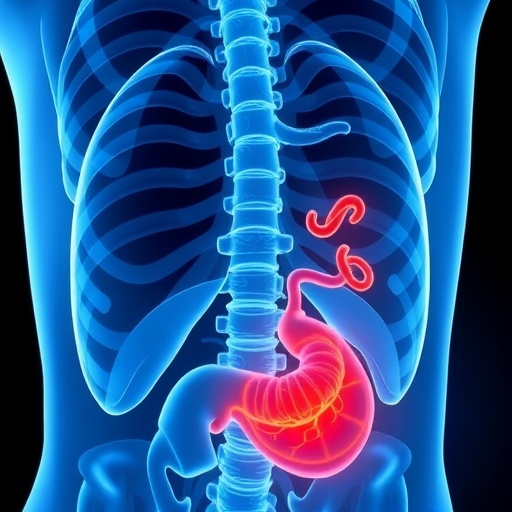A groundbreaking analysis of over 5.2 million hospitalizations across the United States highlights a concerning rise in severe diverticulitis cases among adults under the age of 50. This shift challenges the long-standing perception of diverticulitis as a condition predominantly afflicting older populations, signaling emerging public health implications for younger generations. The study, conducted by researchers from UCLA and Vanderbilt University and published in the prestigious journal Diseases of the Colon & Rectum, meticulously examined inpatient data spanning from 2005 to 2020, revealing new and crucial trends in disease severity, hospitalization interventions, and patient outcomes.
Traditionally, diverticulitis—a condition characterized by the inflammation or infection of small pouch-like structures known as diverticula on the colon wall—has been associated with individuals over 60 years old. The formation of these pouches arises when weaknesses in the colon wall give way under pressure, leading to symptoms ranging from abdominal pain and bloating to gastrointestinal bleeding, constipation, and diarrhea. However, this comprehensive epidemiological analysis lays bare a paradigm shift: more younger adults are being hospitalized for complicated forms of diverticulitis marked by abscesses, perforations, and other severe complications.
The researchers employed the National Inpatient Sample (NIS), the largest publicly accessible all-payer inpatient healthcare database in the U.S., to perform an exhaustive data and statistical examination of diverticulitis-related admissions. Out of the 5.2 million hospitalizations for this condition within the 15-year frame, approximately 837,195 patients (about 16%) were younger than 50, defined as early-onset diverticulitis cases. Notably, within this younger cohort, the incidence of complicated diverticulitis surged dramatically; the proportion of complicated cases rose from 18.5% in 2005 to an alarming 28.2% by 2020, signaling a 52% relative increase.
This upward trend in severe presentations among younger patients is particularly troubling and raises questions about underlying etiologies. Shineui Kim of UCLA Health, the study’s first author, and Dr. Aimal Khan of Vanderbilt University, the principal investigator, emphasize that this trend parallels similar increases in colorectal cancer diagnoses within the same demographic. The intertwining epidemiology of these gastrointestinal disorders in younger people underscores an urgent need for deeper investigation into environmental, lifestyle, metabolic, and possibly genetic contributors.
The complexity of disease manifestation among the younger demographic is further underscored by the paradox observed in treatment outcomes and hospitalization metrics. Despite the increasing severity of cases, the requirement for colectomy—a major surgical procedure involving the removal of parts of the colon—has decreased among younger patients, dropping from 34.7% to 20.3% over the study period. This suggests advances in medical management and conservative treatment strategies, potentially including antibiotics, percutaneous drainage, and improved supportive care regimens, mitigating the need for invasive interventions.
When comparing clinical outcomes across age groups, younger diverticulitis patients exhibit distinct characteristics. They generally experience lower mortality rates, shorter hospital stays averaging nearly a third of a day less than older individuals, and significantly reduced hospitalization costs by nearly $1,900 per admission. While these metrics seem encouraging at first glance, the data simultaneously reveal that younger patients are paradoxically more likely to require invasive interventions. This group demonstrates a 29% higher likelihood of undergoing colectomy and a striking 58% increased chance of needing percutaneous drainage procedures relative to older patients.
These paradoxical findings hint at a potentially more aggressive pathophysiology of diverticulitis in younger individuals or perhaps differences in clinical decision-making influenced by age, comorbidities, and overall health status. The data paints a complex clinical picture; younger patients may present with more severe disease necessitating prompt and robust intervention, yet their general physiological resilience results in better survivability and quicker recoveries compared to their older counterparts.
An important facet of this study is its illumination of the evolving landscape in how diverticulitis is managed within contemporary healthcare systems. The decreasing reliance on surgical colectomies despite increased complications suggests greater adoption of minimally invasive techniques and improved imaging-guided interventions. Furthermore, this shift aligns with broader trends in gastroenterology prioritizing organ preservation, reduced healthcare costs, and enhanced patient quality of life.
The rise in early-onset complicated diverticulitis cases also raises pressing epidemiological and etiological queries. The research team acknowledges the paucity of understanding about why these increases occur specifically among younger adults. Potential hypotheses include dietary shifts characterized by low fiber intake, sedentary lifestyles, escalating obesity rates, alterations in gut microbiota, and increased exposure to environmental pollutants or medications. Moreover, parallels drawn between diverticulitis and colorectal cancer trends may indicate shared risk factors or pathophysiological pathways that warrant rigorous scientific exploration.
Given these findings, the authors call for intensified research efforts to unravel the interplay of lifestyle, genetic, microbiological, and environmental variables contributing to this emerging public health concern. Unveiling causative factors is critical not only for crafting targeted prevention strategies but also for optimizing therapeutic approaches tailored to younger patients with this once predominantly age-associated condition.
The study’s release marks a pivotal moment in gastroenterology, urging healthcare providers, researchers, and policymakers to recognize the shifting epidemiology of diverticulitis. Increasing awareness will likely stimulate enhanced screening and earlier diagnostic interventions in younger populations, potentially averting progression to complicated disease states. Continuing to leverage large-scale healthcare data and integrating novel biomedical research techniques promises to illuminate pathways toward mitigating this troubling trend.
Ultimately, this analysis serves as both a wake-up call and a beacon directing future scientific inquiry. It challenges entrenched clinical assumptions, underscores the dynamic nature of disease epidemiology shaped by societal and environmental changes, and highlights the imperative for a multidisciplinary approach to tackle the burden of diverticulitis among young adults. With sustained focus and innovative research, it may be possible to reverse or even preempt the alarming rise of severe diverticulitis complications in this increasingly vulnerable demographic.
Subject of Research: People
Article Title: National Trends in Hospital Admissions, Interventions, and Outcomes for Early-Onset (Age <50 years) Diverticulitis From 2005 to 2020
News Publication Date: 30-May-2025
Web References:
DOI: 10.1097/DCR.0000000000003668
Keywords: Gastrointestinal disorders, Diseases and disorders, Gastrointestinal tract, Age groups, Adults, Older adults




